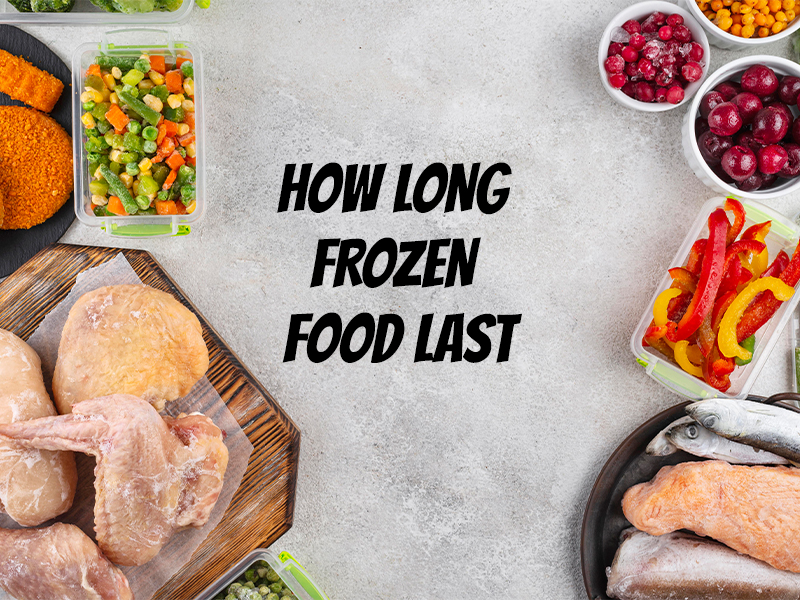Frozen food has made our lives incredibly easy, but it raises concerns about How Long Frozen Food Last. In this blog, we will discuss in detail how you can keep your frozen food fresh. Although frozen food is convenient to use, it still requires some tricks and tips to maintain its freshness.
The Ultimate Guide to Freezing Food: Safety Tips and Shelf Lives
Freezers are a modern marvel, letting us enjoy everything from summer’s bounty of berries in winter to stintless received wisdom on when our food is past its prime. This guide will adjust those timelines to give you a better compass by which to steer your frozen food ship.
Right Freezer Temperature: More Than Just a Cold Number
Understanding proper freezer temperatures isn’t just about keeping things chilly; it’s about food safety and quality. Your freezer should ideally stay at 0 degrees Fahrenheit or below. Anything warmer, and you’re speeding up the expiration date of your foods. Investing in a thermometer for each section of the freezer can pay huge dividends in the long run.
Here’s a quick rundown of what you should keep in mind:
- Regular Freezer: 0°F (-18°C) or lower is perfect for maintaining the quality of your frozen foods.
- Deep Freezer: These can drop as low as -13°F (-25°C) allowing for longer storage but maintaining the 0°F or lower is still essential.
Keep in mind that freezers can lose their chilly efficiency, so it’s worth checking the temperature regularly, especially if you notice ice building up or food not freezing as fast as it used to.
Explore: Food storage guidelines UK
Preventing Freezer Burn: The Crispy Culprit
Freezer burn is the term for when food gets dehydrated from being exposed to air in the freezer. It can manifest as discolored patches or a leathery texture, and while it won’t make you ill, it can really ruin the taste and quality of your food. To keep freezer burn at bay, here’s what you should do:
- Air-tight Packaging: Use vacuum-sealed bags or airtight containers to prevent moisture from escaping and air from getting in.
- Double Wrapping: If you can’t vacuum seal, double wrap in plastic wrap or use zip-top bags and then wrap up in aluminum foil to add an extra layer of protection.
- Smart Storage: Make sure your food is frozen quickly by placing it in the coldest part of your freezer. Once frozen, arrange items so they’re easily accessible and use older items first to prevent them from getting lost in the icy abyss.
By following these simple steps, your food will taste fresher longer, and you’ll be avoiding those unsightly burn spots.
Mastering Frozen Food Shelf Lives
Freezing food effectively pauses the clock on food spoilage, but the clock starts ticking again once you thaw it. Below are general guidelines for how long different foods can last in the freezer:
- Meat and Poultry: Uncooked and cooked meats can last up to a year when properly wrapped and stored, but be sure to check their appearance and smell after thawing.
- Fish: Fatty fish can last six months, while lean fish can last up to eight.
- Breads and Cakes: These can go for 2-3 months without losing texture or flavor.
- Fruits and Vegetables: These can maintain their quality for 8-12 months. However, you may notice some slight changes in taste and texture after 6-8 months.
- Soups and Stews: These are good for 2-3 months and are best reheated directly from frozen.
- Dairy: Soft cheeses are not best for freezing, but harder cheeses can last up to 6 months.
Always label your items with the date so you know when they need to be used. Also, keep in mind that while freezing slows the growth of bacteria, it won’t kill it. Always handle and thaw foods safely, in the fridge or microwave, and never on the counter.
The Thawing Game: Best Practices
Never underestimate the importance of proper thawing! Thawing food at room temperature is a breeding ground for bacteria, especially for high-protein foods like meat and dairy products. Instead, follow these guidelines:
- In the Refrigerator: This is the safest way to thaw most foods. It may take some planning as it’s not the fastest method, but it ensures your food stays cold enough to prevent bacteria growth.
- In Cold Water: Submerge food in airtight packaging in cold water, changing the water every 30 minutes. This can speed things up but needs to be done in a way that water and food don’t mingle.
- In the Microwave: If you’re in a hurry, use the defrost setting. Rotate or stir foods periodically to ensure even thawing.
Never forget to keep an eye on the process, and if you’re not able to cook it right away, move it back into the fridge until you are.
How Long Can Frozen Food Sit Out Before It Goes Bad?
It’s a common conundrum—how long can you leave frozen food out before it starts to spoil? The answer may depend on what it is and the temperature at which it sits. Here’s a general rule of thumb:
- Most food, if kept under 40°F (4°C), will be safe for about two hours. This time frame reduces in warmer temperatures.
- Processed foods with high salt or sugar content may be safer for longer periods, but these should still be monitored.
- Monitor for signs of thaw or temperature abuse—ice crystals or food becoming warm—and use a food thermometer to ensure it’s under 40°F before refreezing.
If in doubt, throw it out. A compromised piece of food can not only taste terrible but could make you pretty ill, and that’s the last thing anyone wants.
For safety and considerations especially for meat, these suggestions can help you play it safe:
- For best quality, meat should never sit out more than two hours at room temperature.
- In a warm room (above 90°F or 32°C), it’s recommended to toss out thawed meats after one hour.
- If you’re in doubt about how long meat has been out, err on the side of caution and discard it.
Remember, it’s not just about spoilage; it’s about safety, too. Bacteria thrives in the “danger zone” between 40°F and 140°F (4°C to 60°C), and this can happen very quickly with meat or other high-protein foods.
Freezing food can be a convenient way to keep food fresh and have meals ready on hand. But it involves a bit of know-how to keep things tasty and safe for consumption. By understanding the basics of freezing and thawing, and following some simple good practices, you can become a freezing aficionado in no time. Your taste buds and your immune system will thank you.
FAQs
Right Freezer Temperature
How to prevent freezer burn?
To prevent freezer burn and keep your food fresh, follow these tips:
- Use Quality Packaging: Ensure your food is tightly wrapped in freezer-safe packaging to prevent air exposure.
- Remove Air: Squeeze out excess air from storage bags before sealing them to minimize air contact with the food.
- Double Wrapping: Consider double wrapping food items or using a layer of plastic wrap followed by aluminum foil.
- Proper Storage: Store food in airtight containers or vacuum-sealed bags to maintain freshness.
- Maintain Freezer Temperature: Keep your freezer at 0°F (-18°C) or below to preserve food quality.
- Rotate Stock: Use older items first to ensure nothing sits in the freezer for too long.
How Long Frozen Food Last?
The shelf life of frozen food can vary depending on the type of food and how well it’s been stored. Here are some general guidelines for how long different types of frozen food can last in the freezer:
- Meat (raw): 3-12 months
- Poultry (raw): 4-12 months
- Fish: 2-6 months
- Cooked Meat and Casseroles: 2-3 months
- Soups and Stews: 2-3 months
- Bread and Baked Goods: 2-3 months
- Fruits and Vegetables: 8-12 months
- Ice Cream: 2-4 months
To ensure the best quality, it’s recommended to label your frozen items with the date they were frozen and follow proper storage guidelines. Always check for signs of freezer burn or deterioration before consuming frozen food.
How long can frozen food sit out before it goes bad?
To prevent freezer burn and keep your food fresh, follow these tips:
- Use Quality Packaging: Ensure your food is tightly wrapped in freezer-safe packaging to prevent air exposure.
- Remove Air: Squeeze out excess air from storage bags before sealing them to minimize air contact with the food.
- Double Wrapping: Consider double wrapping food items or using a layer of plastic wrap followed by aluminum foil.
- Proper Storage: Store food in airtight containers or vacuum-sealed bags to maintain freshness.
- Maintain Freezer Temperature: Keep your freezer at 0°F (-18°C) or below to preserve food quality.
- Rotate Stock: Use older items first to ensure nothing sits in the freezer for too long.




